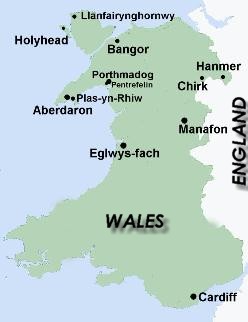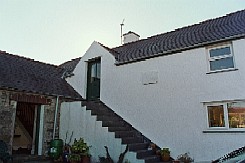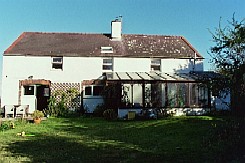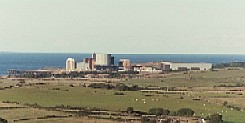




|

|

|

|
||
R.S. moved to Llanfairynghornwy, a remote village near Carmel Head, in 1994 with a Canadian lady, Elisabeth (Betty) Vernon. She and her 3rd husband named Richard Vernon had been very close to him since they met at Eglwys-fach, and he was survived by them after his wife's death.
 His new house was bigger than the one called Sarn-y-Plas and stood on a hill, looking down the Irish Sea and ... the Wylfa Nuclear Power Station (right: taken from the hill behind his house), which he must have hated to see; he was the member of CND (Campaign for Nuclear Disarmament). Although it had been at the end of the Second World War when he had been afraid of nuclear bombs for the first time, his fear for them was never ceased. They were "the ultimate weapons that could not be used without destroying oneself as well as the enemy"1, so he believed that the nuclear or the atomic bombs would bring us Fin de Siecle -- the end of the world (cf., "The Coming").
His new house was bigger than the one called Sarn-y-Plas and stood on a hill, looking down the Irish Sea and ... the Wylfa Nuclear Power Station (right: taken from the hill behind his house), which he must have hated to see; he was the member of CND (Campaign for Nuclear Disarmament). Although it had been at the end of the Second World War when he had been afraid of nuclear bombs for the first time, his fear for them was never ceased. They were "the ultimate weapons that could not be used without destroying oneself as well as the enemy"1, so he believed that the nuclear or the atomic bombs would bring us Fin de Siecle -- the end of the world (cf., "The Coming").
1996 and 1997 were the busy years for him who lived like an old hermit. R.S. married Betty in August 1996, just one month after Richard's death in July. This year also brought him two awards for poetry and he was nominated for the Nobel Prize for Literature in the same year. The next year he published his new book of poetry, although nobody knew it became the last.
R.S. and Betty enjoyed their life very much. They even took a travel to Alaska and after that, R.S. composed one significant poem called 'Alaska'. This is one of other poems not collected in his Collected Poems 2 and published only in 1998 Critical Quarterly.
However these events did not affected his daily life. According to his neighbour whom I could talk with in 2003, he used to go down to Cemlyn Bay alone out of the hill and watch birds. He also walked daily around the hill-top they called "round brick." His favorites never changed. And she described him as a gentleman who had "a very dry sense of humor". She also said, "And he was a lovely man." According to her,
However, had he been described as "a lovely man"? Many people who had met him said he was "gaunt" or "very austere". Tom Davies, a journalist for the Western Mail, said, "his reputation for startling rudeness was completely justified"3 and Byron Rogers depicted that "he is both reserved and cold"4. There was not such a reputation for him as "lovely"; yet he was conjured. Betty enabled him to find a humor, to find a different R.S. really, said the vicar of St. John's Church in Porthmadog, the parish to where Thomases moved the next.
Notes
1.'No One,' Autobiographies, (1997), p.97
2. Collected Poems, I mentioned here, was published in 1990. Since then it has been reissued but never revised, and some poetry remains uncollected. Books published after it (see list of poetry in bibliography section) do not contain 'Alaska.'
3. Tom Davies, Stolen time with R.S.Thomas, (Ship of Fools, 2000)
4. Byron Rogers, Telegraph Magazine, 7 November 1975
It is often said that, although the cold wind always blow throughout the land of Wales, the people in Wales is very warm in their heart and also welcome the others very friendly. And I, a strange traveller from Japan, ensure it; without their kind help, I could not get to the house R.S. once had lived.
I rented a car at Holyhead Ferry Port in the morning of 30 August and first drove around there. And then I decided to set out for Llanfairynghornwy.
Although in his book Mr. Justin Wintle said it was one hour drive from Holyhead to Llanfairynghornwy, it was not enough time for me to reach there just because I was not familiar with Anglesey. Just after setting out by car by myself, I found myself lost .... Some inhabitances gave me the direction and I could get there at last. I parked my car near the graveyard; yet I did not know the address. Well, What shall I do?, I murmured.
I knocked at one door and the story began again. With very kind help from the villagers(hello, Reg!), I found the house finally. As I entered the gate, a car approached me. Introducing myself, I told her that I was looking for the house R.S. once had lived. She said, "It's my house!"
She and her mother, the present owner of this house, were very kind enough to give me a permission to take photos around and inside the house. They also took me to their neighbour who knew both R.S. and Betty well. She also welcomed me very warmly. Very interesting stories were given from her.
How can I describe my thankfulness to all of them? "Thank you very much from my bottom of the heart" is not enough; unfortunately I had and have no words to describe my feeling. But one thing is sure; while in the evening drive to Caernaforn, in where I stayed that night, my heart was filled with happiness and thankfulness to them.
Llanfairynghornwy is a village isolated in the northwest corner in Anglesey and faces to Carmel Head in the west and Cemlyn Bay in the north. National Trust owns a part of Cemlyn Bay for the nature reserve. The Wylfa Nuclear Power Station stands in the northeast of the Bay.
 Pentrefelin and Porthmadog
Pentrefelin and Porthmadog